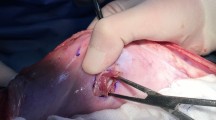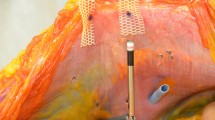Abstract
Purpose
The use of glue as mesh fixation in laparoscopic ventral hernia repair (LVHR) significantly reduces fixation associated morbidity. This experiment evaluates the intraperitoneal use of synthetic glue as single mesh fixation.
Methods
A total of 21 sheep were operated using a hernia model with two fascial defects of 2 cm2 at the linea alba. One week later two polypropylene meshes (Dynamesh®) were implanted laparoscopically, using cyanoacrylate glue (Ifabond®) or conventional fixation (Securestrap®). In half of the animals the fascial defect was closed before mesh placement. After 1 day (n = 6), 2 weeks (n = 8) and 6 months (n = 6), a second laparoscopy was performed at which hernia recurrence, mesh integration and adhesion formation were evaluated. After euthanasia, burst strength testing and histopathology were evaluated.
Results
One animal died due to intestinal incarceration. In 20 surviving animals, no hernias were diagnosed and mesh placement was satisfying. Adhesions could hardly be observed after 1 day but were omnipresent in both groups at 2 weeks and 6 months. Burst strength testing exceeded 100 N in all samples, independent of the fixation device used. Not after 1 day, but after 2 weeks the inflammatory cell response was significantly higher in the glue group. At 6 months minor inflammation was seen, as was foreign body reaction (FBR).
Conclusions
Using a standardized biomechanical testing system, synthetic glue can be considered an effective fixation tool in LVHR. The possible tissue toxicity of cyanoacrylates does not lead to an increased FBR. No difference in burst strength was observed for closing or not closing the defect.




Similar content being viewed by others
References
Fortelny RH, Petter-Puchner AH, Glaser KS, Redl H (2012) Use of fibrin sealant (Tisseel/Tissucol) in hernia repair: a systematic review. Surg Endosc 26:1803–1812
Suzuki S, Ikada Y (2012) Biomaterials for surgical operation. Humana Press/Springer, New York
Olmi S, Cesana G, Sagutti L, Pagano C, Vittoria G, Croce E (2010) Laparoscopic incisional hernia repair with fibrin glue in select patients. JSLS 14:240–245
Eriksen JR, Bisgaard T, Assaadzadeh S, Jorgensen LN, Rosenberg J (2013) Fibrin sealant for mesh fixation in laparoscopic umbilical hernia repair: 1-year results of a randomized controlled double-blinded study. Hernia 17:511–514
Clarke T, Katkhouda N, Mason RJ, Cheng BC, Algra J, Olasky J, Sohn HJ, Moazzez A, Balouch M (2010) Fibrin glue for intraperitoneal laparoscopic mesh fixation: a comparative study in a swine model. Surg Endosc 25(3):737–748
Schug-Pass C, Lippert H, Kockerling F (2009) Fixation of mesh to the peritoneum using a fibrin glue: investigations with a biomechanical model and an experimental laparoscopic porcine model. Surg Endosc 23:2809–2815
Moreno-Egea A (2013) Is sutureless hernia repair a safe option for treating abdominal wall hernias? A prospective study with a synthetic tissue adhesive (n-hexyl-alpha-cyanoacrylate). Cir Esp 91:243–249
Leggat PA, Smith DR, Kedjarune U (2007) Surgical applications of cyanoacrylate adhesives: a review of toxicity. ANZ J Surg 77:209–213
Jourdan IC, Bailey ME (1998) Initial experience with the use of N-butyl 2-cyanoacrylate glue for the fixation of polypropylene mesh in laparoscopic hernia repair. Surg Laparosc Endosc 8:291–293
Testini M, Lissidini G, Poli E, Gurrado A, Lardo D, Piccinni G (2010) A single-surgeon randomized trial comparing sutures, N-butyl-2-cyanoacrylate and human fibrin glue for mesh fixation during primary inguinal hernia repair. Can J Surg 53:155–160
Fortelny RH, Petter-Puchner AH, Walder N, Mittermayr R, Ohlinger W, Heinze A, Redl H (2007) Cyanoacrylate tissue sealant impairs tissue integration of macroporous mesh in experimental hernia repair. Surg Endosc 21:1781–1785
Losi P, Burchielli S, Spiller D, Finotti V, Kull S, Briganti E, Soldani G (2010) Cyanoacrylate surgical glue as an alternative to suture threads for mesh fixation in hernia repair. J Surg Res 163:e53–e58
Ladurner R, Drosse I, Burklein D, Plitz W, Barbaryka G, Kirchhoff C, Kirchhoff S, Mutschler W, Schieker M, Mussack T (2011) Cyanoacrylate glue for intra-abdominal mesh fixation of polypropylene-polyvinylidene fluoride meshes in a rabbit model. J Surg Res 167:e157–e162
Martin-Cartes J, Morales-Conde S, Suarez-Grau J, Lopez-Bernal F, Bustos-Jimenez M, Cadet-Dussort H, Socas-Macias M, Alamo-Martinez J, Tutosaus-Gomez JD, Morales-Mendez S (2008) Use of hyaluronidase cream to prevent peritoneal adhesions in laparoscopic ventral hernia repair by means of intraperitoneal mesh fixation using spiral tacks. Surg Endosc 22:631–634
Schug-Pass C, Lippert H, Kockerling F (2010) Mesh fixation with fibrin glue (Tissucol/Tisseel) in hernia repair dependent on the mesh structure—is there an optimum fibrin-mesh combination?—investigations on a biomechanical model. Langenbecks Arch Surg 395:569–574
Reynvoet E, Berrevoet F, De Somer F, Vercauteren G, Vanoverbeke I, Chiers K, Troisi R (2012) Tensile strength testing for resorbable mesh fixation systems in laparoscopic ventral hernia repair. Surg Endosc 26:2513–2520
LeBlanc KA, Booth WV (1993) Laparoscopic repair of incisional abdominal hernias using expanded polytetrafluoroethylene: preliminary findings. Surg Laparosc Endosc 3:39–41
Wassenaar E, Schoenmaeckers E, Raymakers J, van der Palen J, Rakic S (2010) Mesh-fixation method and pain and quality of life after laparoscopic ventral or incisional hernia repair: a randomized trial of three fixation techniques. Surg Endosc 24:1296–1302
Schoenmaeckers EJ, de Haas RJ, Stirler V, Raymakers JT, Rakic S (2012) Impact of the number of tacks on postoperative pain in laparoscopic repair of ventral hernias: do more tacks cause more pain? Surg Endosc 26:357–360
Muysoms F, Vander Mijnsbrugge G, Pletinckx P, Boldo E, Jacobs I, Michiels M, Ceulemans R (2013) Randomized clinical trial of mesh fixation with “double crown” versus “sutures and tackers” in laparoscopic ventral hernia repair. Hernia 17:603–612
Eriksen JR, Bisgaard T, Assaadzadeh S, Jorgensen LN, Rosenberg J (2011) Randomized clinical trial of fibrin sealant versus titanium tacks for mesh fixation in laparoscopic umbilical hernia repair. Br J Surg 98:1537–1545
Zieren J, Castenholz E, Baumgart E, Muller JM (1999) Effects of fibrin glue and growth factors released from platelets on abdominal hernia repair with a resorbable PGA mesh: Experimental study. J Surg Res 85:267–272
Eriksen JR, Bech JI, Linnemann D, Rosenberg J (2008) Laparoscopic intraperitoneal mesh fixation with fibrin sealant (Tisseel) vs. titanium tacks: a randomised controlled experimental study in pigs. Hernia 12:483–491
Lindstrom I, Suojalehto H, Henriks-Eckerman ML, Suuronen K (2013) Occupational asthma and rhinitis caused by cyanoacrylate-based eyelash extension glues. Occup Med 63:294–297
Toriumi DM, Raslan WF, Friedman M, Tardy ME (1990) Histotoxicity of cyanoacrylate tissue adhesives. A comparative study. Arch Otolaryngol Head Neck Surg 116:546–550
Kukleta JF, Freytag C, Weber M (2012) Efficiency and safety of mesh fixation in laparoscopic inguinal hernia repair using n-butyl cyanoacrylate: long-term biocompatibility in over 1,300 mesh fixations. Hernia 16:153–162
Zinther NB, Wara P, Friis-Andersen H (2010) Intraperitoneal onlay mesh: an experimental study of adhesion formation in a sheep model. Hernia 14:283–289
Klinge U, Klosterhalfen B, Conze J, Limberg W, Obolenski B, Ottinger AP, Schumpelick V (1998) Modified mesh for hernia repair that is adapted to the physiology of the abdominal wall. Eur J Surg 164:951–960
Cobb WS, Burns JM, Kercher KW, Matthews BD, James Norton H, Todd Heniford B (2005) Normal intraabdominal pressure in healthy adults. J Surg Res 129:231–235
Fortelny RH, Petter-Puchner AH, Glaser KS, Offner F, Benesch T, Rohr M (2010) Adverse effects of polyvinylidene fluoride-coated polypropylene mesh used for laparoscopic intraperitoneal onlay repair of incisional hernia. Br J Surg 97:1140–1145
Smietanski M, Bigda J, Iwan K, Kolodziejczyk M, Krajewski J, Smietanska IA, Gumiela P, Bury K, Bielecki S, Sledzinski Z (2007) Assessment of usefulness exhibited by different tacks in laparoscopic ventral hernia repair. Surg Endosc 21:925–928
Rea R, Falco P, Izzo D, Leongito M, Amato B (2012) Laparocopic ventral hernia repair with primary transparietal closure of the hernial defect. BMC Surg 12(Suppl 1):S33
Zeichen MS, Lujan HJ, Mata WN, Maciel VH, Lee D, Jorge I, Plasencia G, Gomez E, Hernandez AM (2013) Closure versus non-closure of hernia defect during laparoscopic ventral hernia repair with mesh. Hernia 17:589–596
Author information
Authors and Affiliations
Corresponding author
Rights and permissions
About this article
Cite this article
Reynvoet, E., Van Cleven, S., Van Overbeke, I. et al. The use of cyanoacrylate sealant as simple mesh fixation in laparoscopic ventral hernia repair: a large animal evaluation. Hernia 19, 661–670 (2015). https://doi.org/10.1007/s10029-015-1347-8
Received:
Accepted:
Published:
Issue Date:
DOI: https://doi.org/10.1007/s10029-015-1347-8




